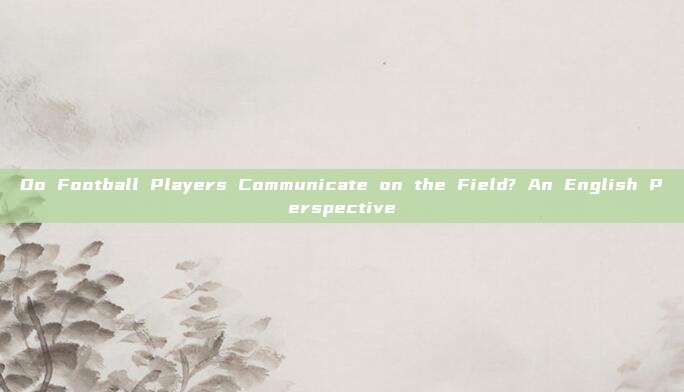 原标题:Do Football Players Communicate on the Field? An English Perspective
原标题:Do Football Players Communicate on the Field? An English Perspective
导读:
文章探讨了足球比赛中球员间的沟通艺术,强调了场上语言与非语言交流的重要性。从简短指令到肢体语言,再到庆祝动作,这些互动不仅提升了团队协作,还展现了多元文化的融合。有效的沟通是球...
**Do Football Players Communicate on the Field? An English Perspective**


**Introduction: The Invisible Game**
In the world of football, every move, every pass, and every goal is a spectacle that captures the hearts and imaginations of millions. Yet, beyond the visible actions on the pitch lies an intricate web of communication that often goes unnoticed by the casual observer. This article delves into the lesser-known aspect of football: the language of the game, specifically from an English perspective. We explore how players communicate with each other during matches, the importance of verbal and non-verbal cues, and the role of culture in shaping these interactions.
**The Art of Verbal Communication**
**1.1 On-Pitch Instructions**
Football is a fast-paced sport where split-second decisions can make all the difference. Verbal communication plays a crucial role in orchestrating team strategies and ensuring players are on the same page. Shouts of "man on!" or "switch!" are common calls used to alert teammates about potential threats or opportunities. These commands are succinct yet powerful, designed to convey essential information quickly and effectively.
**1.2 Leadership and Motivation**
Leadership on the field is often synonymous with vocal presence. Captains and senior players use their voices not only to direct play but also to motivate and inspire their teammates. Encouraging shouts like "keep it up!" or "stay positive!" can significantly impact a team's morale, especially during challenging moments. This verbal support helps maintain focus and unity within the squad.
**1.3 Tactical Adjustments**
Coaches often rely on player feedback to make tactical adjustments during matches. Players might relay messages about opponent weaknesses or changes in the opposition's formation to their coaches via substitutes or directly to their teammates. This two-way communication ensures that teams can adapt their strategies in real-time, giving them a competitive edge.
**The Power of Non-Verbal Cues**
**2.1 Body Language**
Beyond words, body language is a vital component of on-field communication. A simple nod or hand gesture can signal a teammate's intention or confirm understanding without the need for spoken words. For example, a midfielder might point to a specific area of the pitch, indicating where they want the ball to be played next.

**2.2 Eye Contact**
Eye contact is another subtle yet effective form of communication. When a player makes eye contact with a teammate before making a pass, it can instill confidence and ensure precision. This silent exchange of glances is often seen between players who have developed a strong understanding of each other's playing style.
**2.3 Celebrations**
Goal celebrations are more than just jubilant expressions of joy; they can also serve as a form of communication. Teammates often use these moments to reinforce camaraderie and mutual support. Customized goal celebrations, such as mimicking a dance move or a symbolic gesture, can strengthen bonds and boost team spirit.
**The Role of Culture**
**3.1 Linguistic Diversity**
English football is renowned for its multicultural makeup, with players from various backgrounds contributing to the league's vibrancy. This linguistic diversity poses unique challenges and opportunities for communication. Players must learn to understand and adapt to different accents and languages, fostering a more inclusive environment where everyone feels valued.
**3.2 Cultural Nuances**
Cultural nuances can influence communication styles. For instance, some cultures may place greater emphasis on individual expression, while others prioritize collective harmony. Understanding these differences helps players navigate the social dynamics within a team, leading to smoother interactions and a more cohesive unit.
**3.3 International Influence**
The influx of international players has also introduced new communication techniques and traditions. For example, the use of hand signals and visual cues from Latin American football can enhance clarity and efficiency on the pitch. This cross-cultural exchange enriches the game, making it more dynamic and globally connected.
**Conclusion: Unity Through Communication**
In conclusion, the communication between football players is a complex and multifaceted phenomenon that transcends mere words. It involves a blend of verbal instructions, non-verbal cues, and cultural nuances that work together to create a harmonious and effective team. Whether through shouts of encouragement or subtle gestures, players constantly communicate to achieve a shared goal. As fans, we marvel at the skill and athleticism displayed on the field, but it is the invisible game of communication that truly binds a team together, making the beautiful game even more beautiful.
**Epilogue: The Future of Football Communication**
As technology advances, we may see new tools emerge to aid communication on the field. Wearable devices and augmented reality could provide real-time data and instructions to players, further enhancing coordination and strategy. However, at its core, football remains a human endeavor, and the essence of communication will always be rooted in the interpersonal connections forged between teammates.
 原标题:Do Football Players Communicate on the Field? An English Perspective
原标题:Do Football Players Communicate on the Field? An English Perspective







还没有评论,来说两句吧...